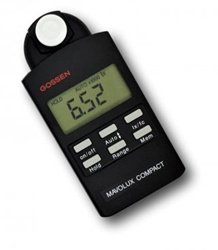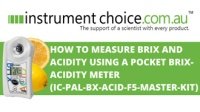How to Measure Light Levels in the Workplace

Why Measure Light Levels in the Workplace
Lighting from natural or artificial sources needs to be provided for employees to ensure working conditions are safe and adequate for the work type performed. Inadequate office lighting will cause visual discomfort, an increased risk of falling or tripping, headaches and more. Optimal office lighting is attributed to better performance and lower levels of eye strain.
To correctly measure workplace lighting, there are three light measurement definitions you need to know. These are;
- Luminous Flux: The total amount of light produced in all directions is the luminous flux.
- Lumen: A lumen is the SI derived unit of luminous flux.
- Lux: Lux (the result you see on your light intensity meter) is one lumen per square meter. Lux indicates the amount of light falling on a surface.
Table 1 (below) provides examples of the Australian standards for recommended lux levels for various types of office activity. The more complex the task, the higher the recommended lux reading.
|
Class of task |
Recommended Maintenance Illuminance (lux) |
Characteristics of the activity and interior |
Example |
|
Intermittent use |
80 |
Interiors requiring intermittent use with visual tasks limited to movement and orientation |
Staff change rooms |
|
Simple |
160 |
Occasional reading of clearly printed documents for short periods |
Waiting rooms |
|
Ordinary or moderately easy |
240 |
Continuously occupied interiors where moderately easy visual tasks with high contrasts or large detail are required |
Computer usage |
|
Moderately difficult |
400 |
Areas where visual tasks are moderately difficult with low contrasts |
Routine office work |
|
Difficult |
600 |
Areas where visual tasks are difficult with low contrasts |
Drawing offices, proofreading etc |
Table 1 The recommended illuminance levels for various office tasks, activities and more (AS1680 – interior lighting).
Measuring Indoor Light
When measuring light levels, it's critical to determine the best light meter for your needs. Not all light meters measure all types of light. There are three main types of light fitting for most indoor settings - each generates light by different means. These are:
- Incandescent: An incandescent bulb creates light by heating a wire filament until it glows.
- LED: Growing rapidly in popularity for indoor environments, LED lights utilise green, red, and blue to achieve warm or cool white tones.
- Fluorescent: A fluorescent lamp exploits low-pressure mercury-vapour gas discharge. An applied electric current excites the mercury vapour to produce short-wave ultraviolet light, which you cannot see with the naked eye. A coating of phosphor lining fluorescent lamps glow when UV light is applied. This glow is the light you see.
Measurement difficulties can arise because incandescent, LED, and fluorescent lights produce light differently. Each produces a different spectral profile, which often requires a different type of light meter sensor.
How to Measure Light Levels in the Workplace
Before measuring workplace lighting, you need to know the type of light you are measuring. Then you can select the most accurate and suitable lux meter for your needs – remembering not all light meters measure all lighting types. When the correct light meter for your application is selected, measurements are straightforward.
To determine the light levels in the workplace using your light meter, follow these steps:
- Remove the sensor cap.
- Place the light intensity meter onto the surface you wish to observe. For work settings, this will be on the work surface, such as a desk. Measuring the horizontal working area will provide an accurate representation of the light intensity reflected in a person's eyes when the surface is in use.
- Wait for the reading on the LCD to stabilise, then record the measurement. When recording the measurement, ensure that your body is not accidentally shading the sensor at any stage.
|
Scientist's Tip 1: Where the working area is unknown, e.g. change rooms or any desk free work areas, measure at a constant height from the floor ~75cm. |
|
Scientist's Tip 2: If the working area is large, it's handy to have a meter with MIN/MAX data retention so you can get a good overall idea of the light in the entire work area. |
Examples of Light Meters
To help illustrate the need to select a suitable device for your light source, the Instrument Choice team has prepared examples of light meters and detailed their specifications.

Testboy TV 335 Digital LED/Lux Light Meter
Product code: IC-TTV-335
The Testboy TV 335 is a digital light meter with an extensive measurement range (up to 400.000 Lux) and a hold function so you can freeze measurements on the LDC. The 335 has photodiodes sensitive to artificial light and adjustable colour temperature. These features make this light intensity meter suitable for measuring LED lighting.
Lux Range:20 lx, 200 lx, 2000 lx, 20000 lx, 400000 lx
Accuracy:3 % V(Lambda) adaptation 2 % cosine correction
Suitable for: Most indoor lighting investigations, including LED.

Light Meter
Product code: IC-CENTER530
The IC-CENTER530 features a rotatable, detachable sensor head and a broad measurement range. It’s well suited for many basic lighting investigations. The IC-CENTER530 light meter features a data hold function as well as minimum and maximum recorded measurement readout.
Lux Range:0.0-199900 lx
Accuracy: ±3%rdg, ±5dgts
Suitable for: Basic lighting investigations. Not for measuring LED light.

MAVOLUX Compact 5032-7
Product code: IC-M502C
Users can measure essentially any standard light source with the IC-M502C light meter. The meter can accurately measure daylight and all artificial light sources, including LED, over a broad spectrum. This light meter stores up to 100 measured readings in its non-volatile memory.
Lux Range:0.1 lx - 199 900 lx with four manual or automatic user-selectable ranges.
Accuracy:3 % of reading + 1 digit
Suitable for: Daylight and almost any standard form of an indoor light source.
Conclusion
Monitoring light levels in the workplace is an essential task to ensure adequate and safe environments.
While monitoring light levels with a light meter is a simple task, selecting the best light meter for your needs can be time-consuming – even intimidating. If you need a hand finding the best light meter for your workplace monitoring application, speak with an Instrument Choice Scientist! We’re here to help! Call 1300 737 871 or email [email protected].

Also interesting
Measuring Brix and acidity is an excellent way for growers, buyers and retailers of fruit to determine its quality, maturity, and value. Atago Instruments offer a series of hybrid Brix-Acid meters so you can accurately measure Brix and acidity percentages and calculate the sugar/acid ratio.
Discover how to use a Brix-Acid meter to ensure the quality of your produce

Instrument Choice’s team of scientists regularly reviews new and popular products, so when searching for the perfect scientific instrument for your application, you can make more informed decisions.
This edition inspects the WET Soil Analysis Kit, a robust, complete solution for the rapid analysis of plant root zones' moisture and nutrient status.
Get our scientists’ review of the WET Kit Soil Moisture Measurement Sensor

